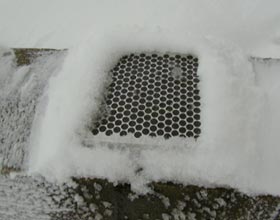Icewick
Anti-slip Grate
Icewick is an anti-icing and anti-slip grate for marine and non-marine applications. The Icewick surface consists of robust grating or tiles that wick an anti-icing fluid to the icing-prone surface from a reservoir layer located beneath. Icewick is designed for use on walkways, stairs, ship decks and in work areas. The system is passive and self-regulating. Fluid can be supplied from a remote location by pump if necessary
Icewick exploits wicking action which utilizes a porous material or wicks that are incorporated within the grating or tile matrix. The base of the wicks are submerged in the anti-icing fluid such that it is drawn to the top surface of the grate. Thus, the formation of ice or accumulation of snow is prevented.
A reservoir system feeds the wicks. The reservoir can either be a dedicated layer and/or be tied into an adjacent or remote reservoir via pumping. Recessing the wicks immediately below the surface allows the fluid to reach the icing substrate yet minimizing tracking.
A key capability of the system is that the melt-water can be absorbed along with the diluted anti-icing fluid, rather than flowing to adjacent surfaces where it could cause other problems. The large surface area of the system helps to evaporate the melt-water. Thus, the full potency of the anti-icing fluid is maintained, and the melt-water is disposed of.
Icewick works well with potassium acetate, which is a highly effective freezing point depressant. Its hygroscopic nature maintains the appropriate chemical potency in a changing moisture environment. It cannot dry out or over-dilute from humidity. Potassium acetate has a sufficiently low corrosivity so that it can be used on aircraft runways as well; it is applied as a liquid to temperatures as low as –29°C.
The Icewick Grate comes in various profiles depending on the reservoir capacity and performance requirements. The standard thickness is 2 cm.
Download Datasheet
Features
- Anti-slip grate
- Prevents ice from forming
- Protects walkways, stairs, ship decks, and work areas
- Passive and self-regulating
- Damage tolerant
- Easy installation